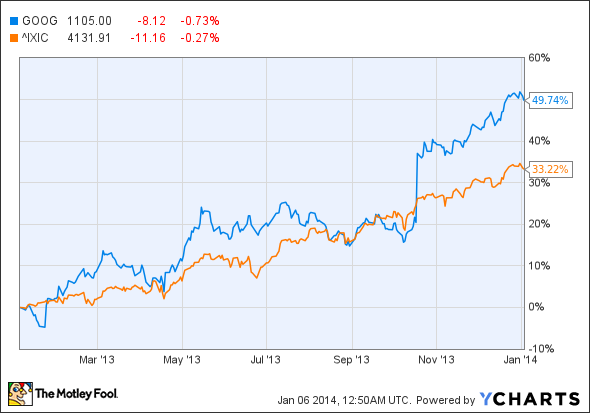The last 12 months have been fantastic for Google (GOOG 0.83%). The company is up by 50%, outperforming the NASDAQ, which is up by a tremendous 33%.
Google has many outstanding properties, including Android, X projects like self-driving cars, and Google Glass. YouTube, though, may have been Google's fastest-growing business unit. According to eMarketer, it grew gross revenue from $3.7 billion to $5.6 billion. Google's cut of that is estimated to be 35%, or $1.95 billion, indicating that YouTube contributed over 6% of Google's advertising revenue.
YouTube is leaving rivals in the dust
Can any other video sharing site compete with YouTube?
YouTube's closest rivals are Vimeo and Dailymotion, with 70 million monthly visitors and 112 million monthly visitors, respectively. YouTube trounces those sites with 450 million monthly visitors. Globally, over 6 billion hours of video content on YouTube is watched each month.
YouTube is like eBay
YouTube is benefiting from strong network effects. Viewers go to YouTube because it has the widest selection of videos, and video creators upload to YouTube because it has the most traffic. This is similar to eBay (EBAY 3.14%) -- buyers go to eBay because it has the widest selection of goods, and sellers use eBay because that's where the buyers go.
These network effects make it almost impossible for incumbents to be displaced by smaller competitors. Companies with a first-mover advantage tend to extend their lead. As it happens, Vimeo was started in November 2004, a few months earlier than YouTube, which was founded in February 2005. YouTube eclipsed Vimeo because, in its early days, it took a more lenient attitude to users uploading copyrighted material.
Amazon successfully challenged eBay
eBay may have started as auction site, but over time it became dominated by new goods selling at a fixed price. This ended up relegating second-hand goods and auctions to a niche status. This has made it more like another incredibly successful 90's start-up, Amazon.com (AMZN +0.40%). Yet, Amazon has managed to muscle in on eBay's territory and now transacts an equally large volume of business through its third-party market place. How did that happen?
eBay lost its position as No. 1 e-commerce site because Amazon managed to create an excellent website experience and customer service for the sale of its goods, and then allowed third-parties to sell through Amazon's website.
Netflix can't challenge YouTube
The difference between eBay and YouTube is the lack of any plausible Amazon-like challenger. Only Netflix (NFLX 0.06%) has the necessary traffic, 1.6 billion hours per month, or roughly a quarter that of YouTube. However, there's one rather large obstacle stopping Netflix from becoming a platform for user-generated content and thus, doing to YouTube what Amazon did to eBay.
That reason is that there's a more significant difference between scripted content and user-generated content than there is between Amazon's products and third-party sellers' products.
It seems the competitive moat around YouTube will only get wider as time goes on.
YouTube is going from strength to strength
YouTube's revenue growth has a few tailwinds worth noting. First, Google's revenue share will trend higher. At the moment, it is estimated that Google's net revenue take is 35%, but the new contracts Google has signed with content creators have a 45%/55% split.
Second, only 14% of YouTube's videos actually contain advertisements. Obviously, some videos don't make for suitable advertising material, but if YouTube can boost the ad-load to double the current percentage to 28%, that should yield substantial incremental revenue. It won't double the revenue, however, because most of the videos with high viewing figures already have ads.
Third, YouTube has also started offering paid channels. Users can subscribe to a variety of content, mostly original. This is similar to how Netflix charges users to watch its library of content. The difference is that subscribers to YouTube channels can pick and choose what specialized content they want to purchase. For example, members might want to only watch foreign films or sci-fi TV shows. For a monthly subscription fee that starts as low as $0.99, they can now do so.










